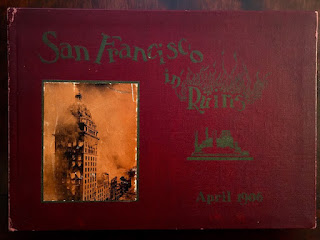This is how author A.M. Allison described the devastating earthquake and fire that struck San Francisco and the surrounding area in the introduction to San Francisco In Ruins: A Pictorial History of Eight Score Photo-Views of the Earthquake Effects, Flames’ Havoc, Ruins Everywhere, Relief Camps. I recently came across this book while reorganizing the Alice’s book collection, and since we are less than two weeks away from the 110th anniversary of the earthquake, it seemed like a good time to take a closer look at it, along with some related items in the museum archives.
 |
| “Citizens Rendezvousing on the Vacant Places When the Fire Was Raging in the Mission District,” J. D. Givens |
As we saw in a previous post, William Miner took up photography as a hobby in the late 1880s, and brought his camera along on his frequent business travels. William frequently traveled to California, first as an employee of the Hutchins Refrigerator Car Company and its subsidiary the California Fruit Transportation Company, and later representing his own company. He visited San Francisco in 1906, at a time when the destruction caused by the earthquake and fire was still very much in evidence, and recorded what he saw in a set of photos now in the Alice’s archives. Here are some of his photographs.
 |
| In the distance is the Fairmont Hotel, which was still under construction at the time of the earthquake |
 |
| Grace Church, California Street |
 |
| In the background are the Call newspaper building and the Mutual Bank building. |
 |
| Another view of the same street. |
It is estimated that between 3,000 and 5,000 people died in the earthquake and subsequent fire, and about three-quarters of the city was damaged. Two years later, people were still living in refugee camps. However, political and business leaders downplayed the effects of the earthquake, fearing loss of outside investment which was desperately needed to rebuild. Reconstruction plans were quickly developed, and less than ten years later, the city hosted the Panama-Pacific International Exposition of 1915. (This world’s fair is also important because it started a fashion for Spanish colonial architecture, which likely influenced the design of Chazy Central Rural School.) But the thousands of photographs in archives, libraries, and personal collections today remain as documents of the events of April 1906.
You can look at a copy of San Francisco in Ruins at the Internet Archive—or come see Alice’s copy when we reopen next month.




No comments:
Post a Comment